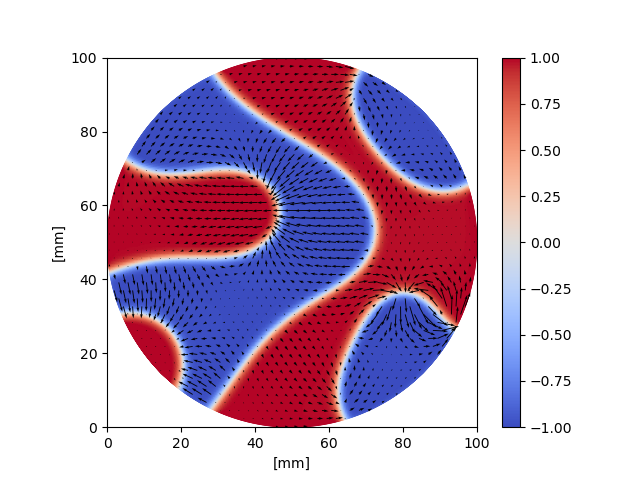
By Evalf, and other Nutils contributors
officialCahn-Hilliard
Solves the Cahn-Hilliard equation, which models the unmixing of two phases
(φ=+1 and φ=-1) under the influence of surface tension. It is a mixed
equation of two scalar equations for phase φ and chemical potential η:
dφ/dt = -div(J(η))
η = ψ'(φ) σ / ε - σ ε Δ(φ)
along with constitutive relations for the flux vector J = -M ∇η and the
double well potential ψ = .25 (φ² - 1)², and subject to boundary conditions
∂ₙφ = -σd / σ ε and ∂ₙη = 0. Parameters are the interface thickness ε,
fluid surface tension σ, differential wall surface tension σd, and
mobility M.
Cahn-Hilliard is a diffuse interface model, which means that phases do not
separate sharply, but instead form a transition zone between the phases. The
transition zone has a thickness proportional to ε, as is readily confirmed
in one dimension, where a steady state solution on an infinite domain is
formed by η(x) = 0, φ(x) = tanh(x / √2 ε).
The main driver of the unmixing process is the double well potential ψ that
is proportional to the mixing energy, taking its minima at the pure phases
φ=+1 and φ=-1. The interface between the phases adds an energy
contribution proportional to its length. At the wall we have a
phase-dependent fluid-solid energy. Over time, the system minimizes the total
energy:
E(φ) := ∫_Ω ψ(φ) σ / ε + ∫_Ω .5 σ ε ‖∇φ‖² + ∫_Γ (σm + φ σd)
╲ ╲ ╲
mixing energy interface energy wall energy
Proof: the time derivative of E followed by substitution of the strong form
and boundary conditions yields dE/dt = ∫_Ω η dφ/dt = -∫_Ω M ‖∇η‖² ≤ 0. □
Switching to discrete time we set dφ/dt = (φ - φ0) / dt and add a
stabilizing perturbation term δψ(φ, φ0) to the double well potential for
reasons outlined below. This yields the following time discrete system:
φ = φ0 - dt div(J(η))
η = (ψ'(φ) + δψ'(φ, φ0)) σ / ε - σ ε Δ(φ)
For stability we wish for the perturbation δψ to be such that the time
discrete system preserves the energy dissipation property E(φ) ≤ E(φ0) for
any timestep dt. To derive a suitable perturbation term to this effect, we
define without loss of generality δψ'(φ, φ0) = .5 (φ - φ0) f(φ, φ0) and
derive the following condition for unconditional stability:
E(φ) - E(φ0) = ∫_Ω .5 (1 - φ² - .5 (φ + φ0)² - f(φ, φ0)) (φ - φ0)² σ / ε
- ∫_Ω (.5 σ ε ‖∇φ - ∇φ0‖² + dt M ‖∇η‖²) ≤ 0
The inequality holds true if the perturbation f is bounded from below such
that f(φ, φ0) ≥ 1 - φ² - .5 (φ + φ0)². To keep the energy minima at the
pure phases we additionally impose that f(±1, φ0) = 0, and select 1 - φ²
as a suitable upper bound. For unconditional stability we thus obtained the
perturbation gradient δψ'(φ, φ0) = .5 (φ - φ0) (1 - φ²).
Finally, we observe that the weak formulation:
∀ δη: ∫_Ω [ dt J(η)·∇δη - δη (φ - φ0) ] = 0
∀ δφ: ∫_Ω [ δφ (ψ'(φ) + δψ'(φ, φ0)) σ / ε + σ ε ∇(δφ)·∇(φ) ] = ∫_Γ -δφ σd
is equivalent to the optimization problem ∂F/∂φ = ∂F/∂η = 0, where
F(φ, φ0, η) := E(φ) + ∫_Ω [ .5 dt J(η)·∇η + δψ(φ, φ0) σ / ε - η (φ - φ0) ]
For this reason, this script defines the stabilizing term δψ, rather than
its derivative δψ', allowing Nutils to construct the residuals through
symbolic differentiation.